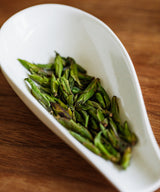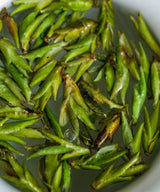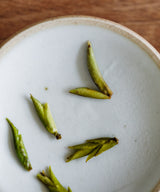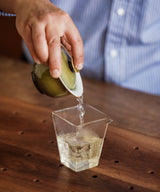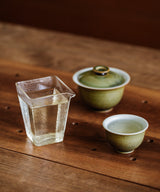Daxueshan Wild Pu'erh Shoots
大雪山野茶
Harvest
March 2025
Origin
Jinggu, Yunnan
When a tea appears more like an animal than a plant, one must take pause to consider where it has come from. This wild pu’erh is made from 1000 year old tea trees that grow on Daxueshan, or Big Snow Mountain. Trees of this age reach very high, and do not grow many leaves. It would be disrespectful, and could possibly hinder the trees growth, to harvest its leaves so instead, this pu’erh is made from what Mr. Tang, who makes it, calls “the shoot.” These buds are dense bundles of newly sprouting leaves, tightly nested within one another such that they appear flanked, like armor.
The first and only time I tried this tea was 5 years ago. Mr. Tang told me how precious this tea was, and that it came from ancient trees deep in the jungle on Daxueshan, near his tea farm in Jinggu, Yunnan. He explained to me that these trees are over 65 feet tall and that, in order for him and the local villagers to gather the shoots, they have to climb up them with their limbs wrapped around the trunk. To collect even a modest amount of shoots the pickers have to pack tents and living supplies in their backpacks and stay on the mountain for at least a night.
In Yunnan, it is a long-standing tradition for the locals to harvest a small amount of fresh shoots from wild tea trees. The shoots would be dried under the sun, or pan-fried. These teas are never for sale in the marketplace, and locals only make enough of it for their own consumption. Many years ago, Mr. Tang went to attend his brother’s wedding on Daxueshan, in Fengqing, Yunnan. This is where he first encountered the wild pu’erh shoot tea made by local villagers. He was immediately captivated by the unique smell of wild flowers present in the tea. Since then, every spring, he would visit a few villages in Daxueshan, collect a small amount of shoots from wild pu’erh trees with the vilalgers, and bring it back to his tea farm. As is the custom, he naturally withered the shoots in a sunroom and then roasted them over charcoal.
At 8200 feet elevation, the jungle terrain where these wild pu’erh trees stand is extremely steep, and a ways away from the nearest village. The trees have grown wild and untamed since they were planted by the ancestors of local, indigenous tribes more than one thousand years ago. These trees are noticeably unique: they are oddly tall, each with distinct character, and their buds emerge like dense bamboo shoots.
Mr. Tang crafts this tea according to the methods that have been passed down through generations of the local people. The shoots are slightly bruised as they are picked from the tree, making the tea naturally slightly fermented. It is dried directly in the sun on bamboo mats after harvesting. Mr. Tang gently agitates the shoots as they are spread out on the mats to enhance the expression of their compelling fragrance. To finish, the shoots are slowly roasted over low-temperature charcoal for at least 2 weeks, removing the “coldness” from these wild tea leaves.
Prized for its energetics, and for offering us such a direct experience of ancient pu’erh trees, this year’s harvest of Daxueshan also delivers a shocking amount of flavour. The dense, freshly harvested buds are bright green with a streak of purple running along one side. They float in the gaiwan like small boats, and smell as though they are carrying an import of tropical fruit.
The liquor they brew is very clear, which can be deceiving, because its taste is anything but watery. The tea feels like electrolyte water on the tongue, and slides across the palate. It tastes like acacia honey and warm cotton before finishing intensely sweet, like dissolved sugar and lychee. These buds teach us something about tea made from ancient trees: they have a way of transmitting their essence through their leaves – we taste their sap, and receive their enduring vitality here.
. . .
Brewing guide
| Tea | 4 g |
| Temperature |
100°C |
| Water | 120 ml |
| Steep time | 10 - 60 sec |
| No. of infusions | 10 |


